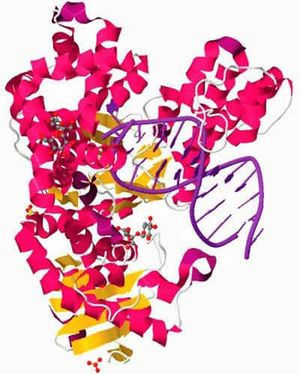This article provides some background information on DNA polymerase to supplement the article Oxford-trained scientist acknowledges the creator
DNA polymerase is an enzyme, a protein ‘machine’ that makes copies of DNA molecules. It is found in all living organisms in various levels of complexity and performs a number of important functions.
For example, our bodies are constantly producing new cells and each one requires its own copy of our DNA. This is produced by the DNA polymerase. This amazing molecular machine is also used to repair damaged DNA and in copying DNA for the purposes of reproduction. Forensic scientists use DNA polymerase taken from bacteria to produce copies of human DNA for ‘genetic finger-printing’.
DNA needs these machines to copy itself, but it also codes the instructions to build its own copying machines. But these instructions to build copying machines can’t be passed on unless copying machines are already present.
DNA is made up of two strands zipped together and wound into a double helix. Before being copied, it must be unwound and unzipped, which is accomplished by another protein machine called a ‘helicase’.
Fast and accurate
The process is very fast and the helicase spins the DNA molecules at the speed of a jet engine. If we were to magnify a typical DNA polymerase machine taken from a bacterium, so that it occupied the same space as a kitchen food mixer, the new DNA strand would be generated at a rate of around 20 km/hour.
It is most important that the DNA polymerase copies the original molecules accurately, as otherwise the information carried by the copy will be corrupted, potentially leading to genetic diseases, birth defects or even cancer.
This is achieved in a number of ways, including the use of a proof-reading system whereby the DNA polymerase checks the copy as it’s produced and cuts out any mistakes. Human DNA polymerase makes less than one mistake in a billion bases (‘letters’). This is equivalent to misspelling one character when you copy the content of one thousand Bibles.
Genetic disorders
Yusdi’s research led to the discovery that, prior to ‘proof-reading’, there is an additional process that screens the DNA ‘letters’ before they are incorporated into the copy (Santoso, Y., et al., ‘Conformational transitions in DNA polymerase1 revealed by single-molecule FRET’, Proceedings of the National Academy of Sciences107(2):715–720, 12 January 2010).
Since defective screening leads to copying errors, Yusdi’s work may contribute to the curing of genetic disorders arising from inefficiencies in this process.
This article is reproduced, with kind permission, from the website of Creation Ministries International (http://creation.com/yusdi-santoso-interview).





















